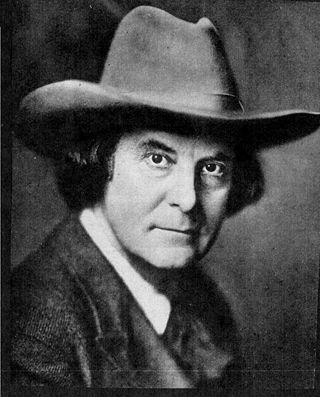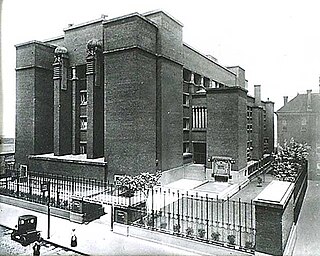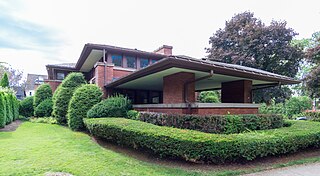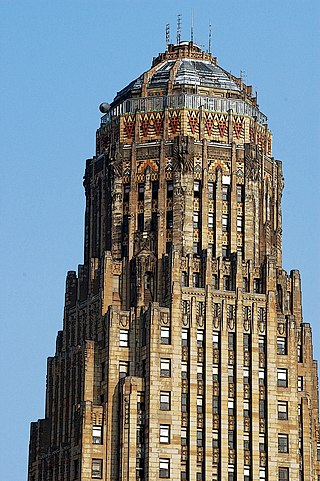Oneida Limited is an American manufacturer and seller of tableware and cutlery. Oneida is one of the world's largest designers and sellers of stainless steel and silverplated cutlery and tableware for the consumer and foodservice industries. It is also the largest supplier of dinnerware to the foodservice industry in North America. The company operates in the United States, Canada, Latin America, Europe, and Asia, marketing and distributing tabletop products, which include flatware, dinnerware, crystal stemware, glassware and kitchen tools and gadgets. The factory in upstate NY was sold to Liberty Tabletop, who is the sole manufacturer of US made flatware. The company originated in the late-nineteenth century in the Oneida Community in Oneida, New York.

Elbert Green Hubbard was an American writer, publisher, artist, and philosopher. Raised in Hudson, Illinois, he had early success as a traveling salesman for the Larkin Soap Company. Hubbard is known best as the founder of the Roycroft artisan community in East Aurora, New York, an influential exponent of the Arts and Crafts movement.

William Mills Wrigley Jr. was an American chewing gum industrialist. He founded the Wm. Wrigley Jr. Company in 1891.

The Darwin D. Martin House is a historic house museum in Buffalo, New York. The property's buildings were designed by renowned architect Frank Lloyd Wright and built between 1903 and 1905. The house is considered to be one of the most important projects from Wright's Prairie School era.

The George F. Barton House was designed by Frank Lloyd Wright, built 1903–1904, and is located at 118 Summit Avenue in Buffalo, New York. The Barton House is part of the larger Darwin D. Martin House Complex, considered to be one of the most important projects from Wright's Prairie School era.

Roycroft was a reformist community of craft workers and artists which formed part of the Arts and Crafts movement in the United States. Elbert Hubbard founded the community in 1895, in the village of East Aurora, New York, near Buffalo. Participants were known as Roycrofters. The work and philosophy of the group, often referred to as the Roycroft movement, had a strong influence on the development of American architecture and design in the early 20th century.

The Larkin Building was an office building in Buffalo, New York, noted for innovations that included central air conditioning, built-in desk furniture, and suspended toilet partitions and bowls. Located at 680 Seneca Street, it was demolished in 1950.

The Graycliff estate was designed by Frank Lloyd Wright in 1926, and built between 1926 and 1931. It is approximately 17 miles southwest of downtown Buffalo, New York, at 6472 Old Lake Shore Road in the hamlet of Highland-on-the-Lake, with a mailing address of Derby. Situated on a bluff overlooking Lake Erie with sweeping views of downtown Buffalo and the Ontario shore, it is one of the most ambitious and extensive summer estates Wright designed. It is now fully restored and operates as a historic house museum, open for guided tours year round. There is also a summer Market at Graycliff, free and open to the public on select Thursday evenings. Graycliff Conservancy is run by Executive Director Anna Kaplan, who was hired in 2019.
The Fiesta Tableware Company is a ceramics manufacturer located in Newell, West Virginia, United States. Established in 1871, it is widely known for its Art Deco glazed dinnerware line, Fiesta. In 2002, The New York Times called Fiesta "the most collected brand of china in the United States".

The Hubbard House is a historic home in Hudson, Illinois, one of two houses on the list of United States Registered Historic Places. The other one, located along the same street, was the Gildersleeve House. The Hubbard House is significant as the boyhood home of American writer and philosopher Elbert Hubbard. Hubbard lived in Hudson and attended school there; he stayed in the village until he was 16. The original wing of the house was built in 1857 by a doctor from Buffalo, New York, Silas Hubbard. In 1872 the two-story section of the house was constructed in a typical I-house design. The home has been listed on the National Register of Historic Places since 1979.

Bertha C. Crawford Hubbard (1861–1946) was one of the founders of the Roycroft movement, an American branch of the Arts and Crafts movement of the late 19th and early 20th centuries.

Darwin Denice Martin was an early 20th-century New York State businessman best known for the house he commissioned Frank Lloyd Wright to design.
Red Wing pottery refers to American stoneware, pottery, or dinnerware items made by a company initially set up in Red Wing, Minnesota, in 1861 by German immigrant John Paul, which changed its names several times until finally settling on Red Wing Potteries, Inc. in 1936. The pottery factory that started in 1861 continues to the present day under the names of Red Wing Pottery and Red Wing Stoneware. There was a respite in production when Red Wing Pottery Sales, Inc. had a strike in 1967 causing them to temporarily cease trading. The company still makes both zinc/Bristol glazed products as well as salt-glazed, hand-thrown, kiln fired items.

The William R. Heath House was designed by Frank Lloyd Wright, built from 1903 to 1905, and is located at 76 Soldiers Place in Buffalo, New York. It is built in the Prairie School architectural style. It is a contributing property in the Elmwood Historic District–East historic district and a City of Buffalo landmark.

The Architecture of Buffalo, New York, particularly the buildings constructed between the American Civil War and the Great Depression, is said to have created a new, distinctly American form of architecture and to have influenced design throughout the world.
Upstate New York has been the setting for inventions and businesses of international significance. The abundance of water power and the advent of canal and rail transportation provided nineteenth century upstate New York entrepreneurs with the means to power factories and send their products to market. In the twentieth century, hydroelectric power and the New York State Thruway served the same roles. In April 2021, GlobalFoundries, a company specializing in the semiconductor industry, moved its headquarters from Silicon Valley, California to its most advanced semiconductor-chip manufacturing facility in Saratoga County, New York near a section of the Adirondack Northway, in Malta, New York.

Restaurant ware, or most commonly hotelware, is vitrified, ceramic tableware which exhibits high mechanical strength and is produced for use in hotels and restaurants. Tableware used in railway dining cars, passenger ships and airlines are also included in this category.

The Larkin Company, also known as the Larkin Soap Company, was a company founded in 1875 in Buffalo, New York as a small soap factory. It grew tremendously throughout the late 1800s and into the first quarter of the 1900s with an approach called "The Larkin Idea" that transformed the company into a mail-order conglomerate that employed 2,000 people and had annual sales of $28.6 million in 1920. The company's success allowed them to hire Frank Lloyd Wright to design the iconic Larkin Administration Building which stood as a symbol of Larkin prosperity until the company's demise in the 1940s.

Larkinville, also known as The Hydraulics, is an area of Buffalo, New York located near downtown, South Buffalo and Canalside. Once an industrial neighborhood, it is now home to offices, shops, and a public gathering space called Larkin Square that regularly features food trucks, events, and concerts. The current form of the neighborhood came as a result of the gentrification of the former headquarters complex of the Larkin Soap Company, which includes the Larkin Terminal Warehouse, and other abandoned warehouses nearby.

Buffalo China, Inc., formerly known as Buffalo Pottery, was a company founded in 1901 in Buffalo, New York as a manufacturer of semi-vitreous, and later vitreous, china. Prior to its acquisition by Oneida Ltd. in 1983, the company was one of the largest manufacturers of commercial chinaware in the United States.
















